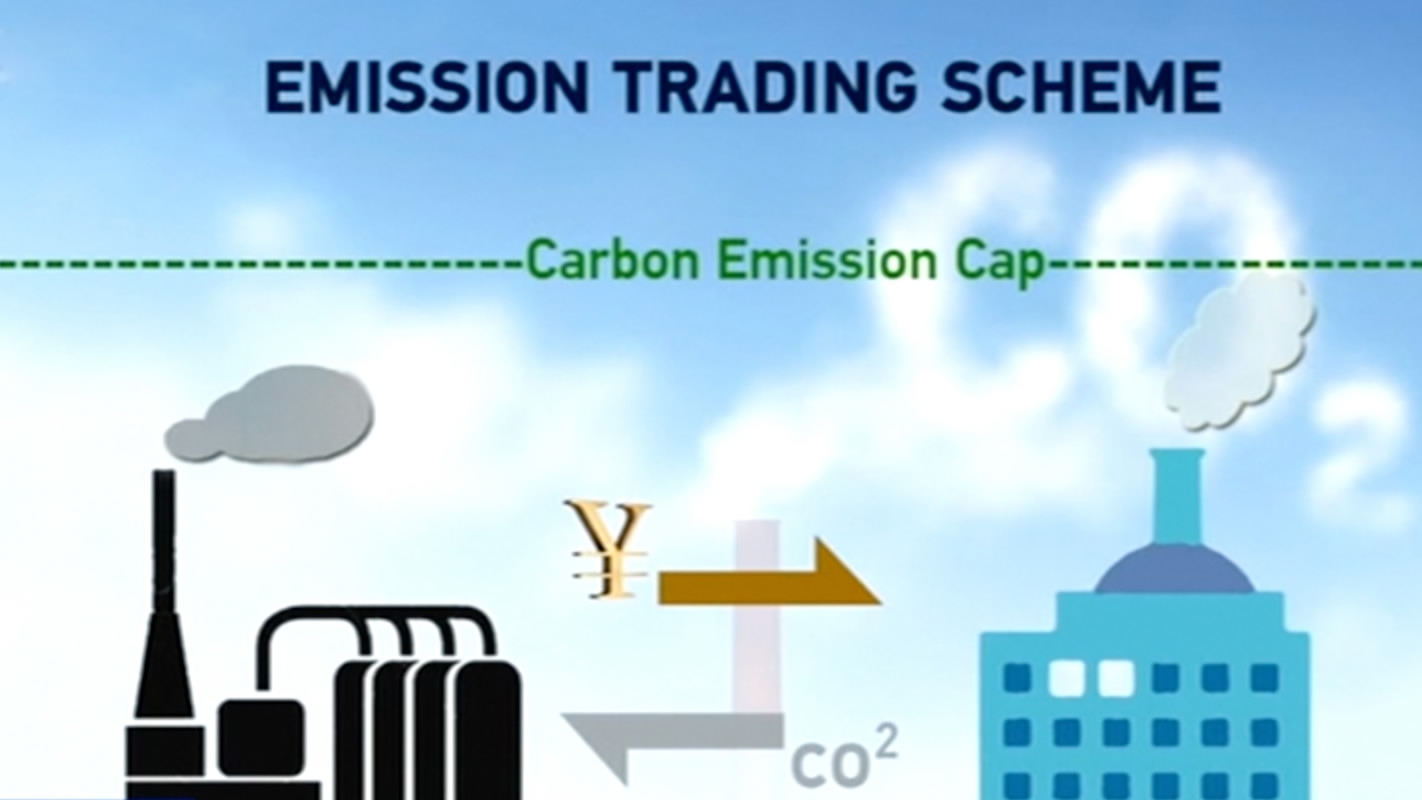Introduction
Welcome to the world of emissions trading, a concept that has gained significant attention in recent years as a solution to mitigating climate change. As concerns about greenhouse gas emissions and their impact on the environment continue to mount, governments, businesses, and individuals are seeking innovative ways to reduce their carbon footprints and contribute to a more sustainable future. Emissions trading, also known as cap and trade, has emerged as a market-based mechanism that aims to tackle this pressing issue.
In this article, we will explore the fundamentals of emissions trading, how it works, its history, and its benefits and challenges. We will also touch on international emissions trading schemes that have been implemented to address global greenhouse gas emissions. By gaining a deeper understanding of emissions trading, you will be equipped with the knowledge to comprehend its significance and potential impact on our environment.
Before delving into the intricacies of emissions trading, it is essential to grasp the concept of emissions. The term “emissions” refers to the release of pollutants, particularly greenhouse gases, into the atmosphere. These gases, such as carbon dioxide (CO2), methane (CH4), and nitrous oxide (N2O), are primarily produced through human activities such as burning fossil fuels, deforestation, and industrial processes. The accumulation of these gases in the atmosphere leads to the phenomenon known as global warming, which is responsible for climate change.
Climate change, with its far-reaching consequences, presents a significant challenge for our planet and its inhabitants. Rising global temperatures, extreme weather events, and the loss of biodiversity are just a few examples of the detrimental effects caused by greenhouse gas emissions. It is imperative that we take action to reduce these emissions and mitigate the impacts of climate change.
Emissions trading provides a mechanism for achieving emission reductions by setting a limit, or cap, on the total amount of emissions allowed within a certain timeframe. This cap is typically determined by government regulations or international agreements. Within this cap, companies or entities are allocated or required to purchase permits, known as emissions allowances, which allow them to emit a certain amount of greenhouse gases. The key principle behind emissions trading is to create a financial incentive for reducing emissions, as companies that emit less than their allocated allowances can sell their surplus allowances to those who exceed their emissions limits.
Emissions trading has gained traction worldwide due to its potential to achieve emission reductions in a cost-effective manner. By creating a market for emissions allowances, it encourages companies to invest in cleaner technologies, improve energy efficiency, and adopt sustainable practices. Additionally, it provides flexibility for businesses to choose how they reduce emissions, allowing them to find the most economical and efficient solutions for their specific circumstances.
While emissions trading offers numerous advantages, it also poses challenges that must be addressed to ensure its effectiveness. Issues such as setting appropriate emissions caps, monitoring and enforcing compliance, and preventing market manipulation require careful consideration and strong regulatory frameworks. Furthermore, international cooperation and coordination are essential for a global emissions trading system to be truly effective in reducing greenhouse gas emissions on a large scale.
In the following sections, we will delve deeper into the specific mechanisms of emissions trading, its history, benefits, challenges, and international initiatives. By uncovering the complexities and nuances of emissions trading, we can gain a comprehensive understanding of this vital tool in the fight against climate change.
What are Emissions?
To comprehend the concept of emissions trading, it is crucial to have a clear understanding of what emissions are. Emissions refer to the release of pollutants, particularly greenhouse gases, into the atmosphere. These gases, including carbon dioxide (CO2), methane (CH4), and nitrous oxide (N2O), are generated primarily by human activities such as burning fossil fuels for energy, deforestation, and industrial processes.
Greenhouse gases have the ability to trap heat in the Earth’s atmosphere and contribute to the greenhouse effect, which leads to global warming. This process occurs naturally and is essential for maintaining a stable climate on our planet. However, human activities have greatly accelerated the release of these gases, resulting in an imbalance and an alarming increase in global temperatures.
Carbon dioxide is the most prevalent greenhouse gas and responsible for about three-quarters of the total emissions. It is primarily released during the combustion of fossil fuels for energy production, transportation, and industrial processes. Methane, though present in smaller quantities, has a more potent warming effect compared to carbon dioxide. It is mainly released during the production and transport of coal, oil, and natural gas, as well as from agricultural activities and waste management. Nitrous oxide, primarily released from agricultural and industrial activities, is another powerful greenhouse gas with a long atmospheric lifespan.
It is important to note that not all emissions are the same. Different gases have varying warming potentials, also known as global warming potentials (GWPs). GWPs are a measure of the ability of a greenhouse gas to trap heat compared to carbon dioxide over a specific time period. For example, methane has a GWP of 28-36 times that of carbon dioxide over a 100-year period, while nitrous oxide has a GWP of 265-298 times that of carbon dioxide. This variation in GWPs highlights the urgency of addressing emissions across all sectors and gases to effectively mitigate climate change.
It is worth mentioning that greenhouse gas emissions are not solely attributable to human activities. Natural processes such as volcanic eruptions, forest fires, and decomposition of organic matter also release significant amounts of greenhouse gases. However, the focus of emissions trading and other mitigation efforts is primarily on reducing anthropogenic, or human-caused, emissions.
Understanding emissions and their impact is crucial for formulating effective solutions to combat climate change. By reducing emissions and transitioning to cleaner and more sustainable practices, we can mitigate the detrimental effects of greenhouse gases and work towards a more resilient and environmentally friendly future.
The Problem of Greenhouse Gas Emissions
Greenhouse gas emissions pose a significant problem for the planet and its inhabitants. The excessive release of these gases into the atmosphere has resulted in various adverse effects, collectively known as climate change. The consequences of climate change are wide-ranging and impact ecosystems, communities, and economies around the globe.
One of the most significant effects of greenhouse gas emissions is the rise in global temperatures. The Earth’s average temperature has increased by approximately 1 degree Celsius since the Industrial Revolution. This may not seem like a significant difference, but it has far-reaching implications. Rising temperatures contribute to the melting of glaciers and polar ice caps, leading to sea-level rise. This threatens coastal cities and low-lying areas with increased risk of flooding and erosion.
Climate change also disrupts weather patterns and leads to more extreme and unpredictable events. Heatwaves become more frequent and intense, posing risks to human health, especially for vulnerable populations. Droughts become more severe, affecting agricultural productivity and water supplies. On the other hand, heavy rainfall and flooding cause extensive damage to infrastructure and livelihoods. These extreme weather events have direct impacts on human well-being, food security, and the availability of freshwater resources.
The impacts of climate change are not limited to the physical environment. Biodiversity loss is a significant consequence of rising temperatures and changing habitats. Species are unable to adapt quickly enough to the changing climate, leading to population decline and, in some cases, extinction. This loss of biodiversity not only disrupts ecosystems but also threatens the delicate balance on which humans depend for resources such as food, medicine, and clean water.
Moreover, climate change has socio-economic implications. Agricultural productivity is affected by changes in rainfall patterns, temperature extremes, and the spread of pests and diseases. This can result in reduced crop yields, increased food prices, and decreased food security. The tourism industry, which often relies on natural environments and scenic landscapes, may suffer due to the degradation of these assets caused by climate change. Additionally, the displacement of communities due to sea-level rise or severe weather events puts pressure on already strained resources and can lead to social and political instability.
Addressing the problem of greenhouse gas emissions is crucial to mitigate climate change and its far-reaching consequences. By reducing emissions and transitioning to sustainable and low-carbon alternatives, we can limit the extent of global warming and minimize the impacts on both natural systems and human societies. Emissions trading offers a market-based mechanism to incentivize emission reductions and drive the transition towards a more sustainable future.
What is Emissions Trading?
Emissions trading, also known as cap and trade, is a market-based approach to reducing greenhouse gas emissions. It works on the principle of setting a limit, or cap, on the total amount of emissions allowed within a specific timeframe. This cap is typically determined by government regulations or international agreements.
Under an emissions trading system, companies or entities are allocated or required to purchase permits, known as emissions allowances, which represent the right to emit a specified amount of greenhouse gases. Each allowance corresponds to a certain quantity of emissions, usually measured in metric tons of carbon dioxide equivalent (CO2e). These allowances can be bought, sold, or traded among participants in the emissions trading market.
The key principle behind emissions trading is to create a financial incentive for emissions reduction. Companies that emit less than their allocated allowances can sell their surplus allowances to those who exceed their emissions limits. This allows for flexibility in achieving emission reductions, as it allows companies to choose the most cost-effective and efficient methods of reducing emissions that suit their specific circumstances. It also encourages innovation and investment in cleaner technologies and practices.
Emissions trading operates on the idea of the law of supply and demand. The total number of allowances available in the market represents the overall emissions cap. As companies strive to meet their emissions targets, the demand for allowances increases. If a company surpasses its allocated allowances, it must purchase additional allowances to comply with regulations. Conversely, if a company emits less than its allocated allowances, it can sell its excess allowances and generate revenue.
To ensure transparency and accountability, emissions trading systems typically require participants to report their emissions accurately and undergo regular monitoring and verification. This helps prevent fraud, double-counting, and ensures the integrity of the market. Additionally, penalties may be imposed on companies that fail to comply with emission limits or engage in non-compliant practices.
Emissions trading can take various forms, from regional or national systems to international schemes. These schemes may differ in terms of the types of greenhouse gases covered, the sectors included, and the specific rules and mechanisms governing the trading process. However, they all share the common goal of reducing overall emissions through market-based incentives.
Overall, emissions trading provides a mechanism to facilitate emission reductions in a cost-effective and flexible manner. By creating a market for emissions allowances, it encourages companies to invest in cleaner technologies, improve energy efficiency, and adopt sustainable practices. It also offers opportunities for economic growth, job creation, and the transition to a low-carbon economy. As such, emissions trading plays a vital role in addressing climate change and achieving a more sustainable future.
How Does Emissions Trading Work?
Emissions trading, also known as cap and trade, operates through a system of allowances and permits that enable the trading of greenhouse gas emissions. The process involves several key steps to facilitate the buying, selling, and monitoring of emissions allowances.
1. Establishing a Emissions Cap: The first step in emissions trading is the establishment of a regulatory framework that sets a cap on the total amount of greenhouse gas emissions allowed within a specified timeframe. This cap is typically determined by government regulations or international agreements and aims to achieve emission reduction targets.
2. Allocating Emissions Allowances: Once the emissions cap is established, emissions allowances are allocated to participating entities. These entities may include industrial facilities, power plants, or other sources of greenhouse gas emissions. The allocation process can be based on historical emission levels, regional emission reduction targets, or other distribution methods. Each allowance represents the right to emit a specified amount of greenhouse gases, usually measured in metric tons of carbon dioxide equivalent (CO2e).
3. Monitoring and Reporting Emissions: Participants in the emissions trading system are required to monitor and report their emissions accurately and transparently. This ensures the integrity of the market and prevents fraud or double-counting. Monitoring can involve the use of emissions monitoring equipment, data collection, and regular reporting to regulatory authorities.
4. Compiling a Registry: A registry is established to record and verify the ownership and transfer of emissions allowances. This registry serves as a transparent and publicly accessible database that tracks the movement of allowances within the emissions trading system. It enables participants to buy, sell, or transfer their allowances securely and ensures the accurate accounting of emissions reductions.
5. Trading Emissions Allowances: Once the emissions allowances are allocated, participants can engage in buying and selling of these allowances in the emissions trading market. The market can be facilitated through regulated exchanges, brokers, or electronic trading platforms. Companies that emit more than their allocated allowances can purchase additional allowances from other participants, while those that emit less have the option to sell their surplus allowances.
6. Evaluating Compliance: Compliance with the emissions cap and allowance requirements is closely monitored and enforced. Participants are generally required to surrender a sufficient number of allowances to cover their actual emissions within a specified compliance period. Failure to meet compliance obligations may result in penalties or other enforcement actions.
7. Flexibility and Innovation: Emissions trading offers flexibility and encourages innovation in emission reduction strategies. Participants have the flexibility to choose the most cost-effective and efficient methods of reducing emissions that suit their specific circumstances. This flexibility drives investment in cleaner technologies, energy efficiency, and sustainable practices.
Overall, emissions trading works by creating a market for emissions allowances, which drives emission reductions in a cost-effective manner. It allows for the trading of emissions allowances among participants, providing financial incentives for reducing emissions and facilitating the transition to a low-carbon economy. By harnessing market forces, emissions trading plays a crucial role in addressing climate change and achieving sustainable development goals.
The History of Emissions Trading
The concept of emissions trading can be traced back to the 1960s, with early discussions and proposals on using market mechanisms to address air pollution. However, it wasn’t until the late 1980s that emissions trading gained significant attention as a tool to combat global warming and reduce greenhouse gas emissions.
The first large-scale emissions trading program was implemented in the United States in the early 1990s to address acid rain caused by sulfur dioxide (SO2) emissions from power plants. The program, known as the Acid Rain Program, was established under the Clean Air Act Amendments of 1990. It introduced a cap-and-trade system for SO2 emissions, allowing power plants to buy and sell emissions allowances. The program proved to be successful in reducing SO2 emissions at a lower cost than traditional command-and-control regulations.
Building on the success of the Acid Rain Program, the concept of emissions trading was further developed to address greenhouse gas emissions, particularly carbon dioxide (CO2). The 1997 Kyoto Protocol, an international agreement to combat climate change, introduced the Clean Development Mechanism (CDM) and Emissions Trading Mechanism (ETM) as flexible mechanisms to achieve emission reduction targets. The CDM allows developed countries to invest in emission reduction projects in developing countries and receive carbon credits in return. The ETM enables the trade of emissions allowances among participating countries to meet their emission reduction commitments.
In 2005, the European Union launched the world’s first mandatory greenhouse gas emissions trading system, known as the EU Emissions Trading System (EU ETS). It covers various sectors, including energy, manufacturing, and aviation, and has expanded over time. The EU ETS has faced challenges, including an initial oversupply of allowances and issues related to emissions monitoring and verification. However, it has also demonstrated the potential of emissions trading as a tool for achieving emission reduction targets.
Emissions trading has continued to evolve and expand globally. Various countries, such as Australia, New Zealand, and South Korea, have implemented national emissions trading systems that cover multiple sectors. Additionally, regional emissions trading systems have been established in North America, such as the Regional Greenhouse Gas Initiative (RGGI) in the northeastern United States and the Western Climate Initiative (WCI) in several western states and Canadian provinces.
The Paris Agreement, adopted in 2015, further emphasizes the role of emissions trading in addressing climate change. It encourages countries to use market-based approaches, including emissions trading systems, to reach their emission reduction targets. The agreement also calls for the establishment of a sustainable development mechanism to support the mitigation of greenhouse gas emissions and promote sustainable development.
Looking ahead, emissions trading is expected to play an increasingly significant role in global efforts to mitigate climate change. As countries strive to achieve their emission reduction commitments under various international agreements, the development and expansion of emissions trading systems will continue to be a critical component of the solution.
The Benefits of Emissions Trading
Emissions trading, also known as cap and trade, offers several notable benefits in the fight against climate change and the reduction of greenhouse gas emissions. These benefits contribute to a more sustainable and environmentally conscious future.
1. Cost-Effectiveness: Emissions trading provides a cost-effective approach to reducing greenhouse gas emissions. By establishing a market for emissions allowances, it creates a financial incentive for companies to invest in cleaner technologies and practices. Companies that can achieve emission reductions at a lower cost can sell their surplus allowances, while those facing higher costs can purchase allowances to meet their compliance obligations. This flexibility allows for the achievement of overall emission reduction targets at a lower cost than traditional command-and-control regulations.
2. Innovation and Technological Advancement: Emissions trading promotes innovation and technological advancement in emission reduction strategies. The financial incentives provided by the trading system encourage companies to explore and invest in cleaner technologies and practices that can help reduce emissions more efficiently. This drives research and development in renewable energy, energy efficiency, and other sustainable solutions, leading to a transition to a low-carbon economy.
3. Flexibility: Emissions trading offers flexibility in meeting emission reduction targets. Unlike prescriptive regulations that dictate specific actions, emissions trading provides companies with the freedom to choose the most cost-effective methods of reducing emissions. This flexibility allows for diverse approaches tailored to the circumstances of each entity, promoting efficiency and optimizing the use of resources.
4. Impact on International Cooperation: Emissions trading can facilitate international cooperation in tackling climate change. By allowing for the trade of emissions allowances, countries and entities can work together to achieve emission reduction targets more effectively. Emissions trading also enables the transfer of technologies and knowledge, promoting collaboration and capacity-building between countries.
5. Environmental Integrity: Emissions trading contributes to environmental integrity through emissions monitoring and reporting requirements. These requirements help ensure accurate accounting of emissions and prevent fraud or double-counting. Emissions trading systems also provide a transparent mechanism for tracking emission reductions and promoting accountability.
6. Global Scalability: Emissions trading can be scaled up globally, enabling broader participation and impact. International cooperation and the linking of emissions trading systems between countries and regions can create a larger market for emissions allowances. This increased scalability has the potential to achieve more significant emission reductions and address global climate goals.
7. Additional Co-Benefits: Emissions trading can generate additional co-benefits beyond emission reductions. These can include improved air quality, reduced dependence on fossil fuels, job creation in clean energy sectors, and enhanced energy security. Emphasizing these co-benefits can further incentivize participation in emissions trading and bring about positive social, economic, and environmental outcomes.
The benefits of emissions trading make it a valuable tool in addressing climate change and transitioning to a sustainable future. As more countries and entities implement emissions trading systems, the potential for achieving substantial emission reductions increases, paving the way for a lower-carbon and more environmentally resilient world.
The Challenges of Emissions Trading
While emissions trading offers numerous benefits, it also faces several challenges that need to be addressed for its effective implementation and success in reducing greenhouse gas emissions.
1. Setting Appropriate Cap and Allocation: One challenge is setting appropriate emissions caps that align with emission reduction targets. Determining the right level of the cap requires careful consideration of scientific evidence, economic factors, and policy objectives. Similarly, allocating emissions allowances among participants must be fair and equitable to avoid potential inequities or market distortions.
2. Monitoring, Reporting, and Verification: Ensuring the accuracy and reliability of emissions data is crucial for the integrity of emissions trading systems. Monitoring and reporting emissions can be complex, requiring standardized methodologies and continuous monitoring efforts. Independent verification processes must be in place to prevent fraud or inaccurate reporting and provide confidence in the transparency and credibility of emissions data.
3. Market Stability and Price Volatility: Emissions trading markets can be subject to price volatility and uncertainty. Factors such as changes in economic conditions, regulatory decisions, or fluctuations in international carbon markets can influence the price of emissions allowances. These fluctuations can affect the economic incentives for emissions reductions and create challenges for businesses, especially those with long-term planning and investment needs.
4. Preventing Market Manipulation: Emissions trading systems must guard against market manipulation, including price manipulation or collusion among market participants. Strong regulatory oversight and enforcement mechanisms are necessary to prevent market abuses and ensure a level playing field for participants.
5. International Cooperation and Harmonization: Globally coordinated emissions trading systems require international cooperation and harmonization. Differences in emissions measurement, reporting standards, and regulatory frameworks can create challenges for the compatibility and linkage of multiple emissions trading schemes. Achieving international cooperation and consensus is crucial to maximize emissions reduction potential and avoid potential trade imbalances or leakage.
6. Addressing Carbon Leakage: Carbon leakage occurs when emission-intensive industries relocate to regions with fewer or no emission reduction measures, resulting in a shift of emissions rather than actual reductions. Emissions trading systems need to address this challenge by considering measures, such as border carbon adjustments or complementary policies, to prevent carbon leakage and ensure the global effectiveness of emission reduction efforts.
7. Public Perception and Acceptance: Public perception and acceptance are essential for the success of emissions trading systems. Engaging and educating the public about the benefits and importance of emissions trading is crucial, as misconceptions or resistance may hinder its implementation or effectiveness. Enhancing transparency and fostering public trust can help build support for emissions trading as a viable solution to address climate change.
Addressing these challenges requires robust regulatory frameworks, effective governance, stakeholder engagement, and ongoing monitoring and evaluation. By addressing these challenges, emissions trading systems can better realize their potential to drive emission reductions and contribute to a more sustainable future.
International Emissions Trading Schemes
International cooperation and coordination are crucial for addressing global greenhouse gas emissions and mitigating climate change. Several international emissions trading schemes have been established to facilitate emission reduction efforts and promote collaboration among countries. These schemes aim to create a global market for emissions allowances, harmonize emission reduction targets, and encourage the sharing of best practices and technologies.
1. Kyoto Protocol’s Clean Development Mechanism (CDM) and Emissions Trading Mechanism (ETM): The Kyoto Protocol, an international treaty to combat climate change, introduced the CDM and ETM as flexible mechanisms for achieving emission reduction targets. The CDM allows developed countries to invest in emission reduction projects in developing countries and receive carbon credits in return. These credits can be used to meet emission reduction commitments. The ETM enables the trade of emissions allowances among participating countries, supporting their efforts to meet emission targets.
2. European Union Emissions Trading System (EU ETS): The EU ETS is the world’s largest mandatory greenhouse gas emissions trading system. It covers various sectors, including energy, manufacturing, and aviation, across European Union member states. The EU ETS operates under a cap-and-trade mechanism, with a gradually decreasing emissions cap over time. It has undergone several phases and revisions to improve its effectiveness and address challenges such as oversupply of allowances. The EU ETS is linked to international credits, allowing for global emission reduction efforts.
3. Regional Greenhouse Gas Initiative (RGGI): The RGGI is a regional cap-and-trade program in the northeastern United States. It covers ten states and aims to reduce carbon dioxide emissions from the power sector. The program sets annual emission caps and allows for the trading of emissions allowances. The RGGI has proven to be successful in reducing emissions while driving investments in clean energy technologies and stimulating economic growth in the participating states.
4. Western Climate Initiative (WCI): The WCI is a collaboration between several western states in the United States and Canadian provinces to reduce greenhouse gas emissions. The WCI aims to establish a regional cap-and-trade system covering multiple sectors, including electricity generation, industry, and transportation. The initiative focuses on setting emission reduction targets, harmonizing measurement and reporting standards, and facilitating the trading of emissions allowances across jurisdictions.
5. International Civil Aviation Organization (ICAO) Carbon Offsetting and Reduction Scheme for International Aviation (CORSIA): CORSIA is an international program developed by the ICAO to address the carbon emissions of the aviation industry. It aims to achieve carbon-neutral growth from 2020 onwards by requiring airlines to offset their emissions through the purchase of carbon offsets or the use of emissions allowances from the international market. CORSIA creates a framework for international cooperation, providing a standardized approach to offset aviation emissions globally.
These international emissions trading schemes provide platforms for countries and regions to work together towards common emission reduction goals. They encourage the exchange of knowledge, technology transfer, and financial flows to support sustainable development while reducing greenhouse gas emissions. However, challenges such as linking different trading schemes, ensuring environmental integrity, and harmonizing regulations remain areas for ongoing development and improvement in international emissions trading.
Conclusion
Emissions trading, with its market-based approach, has emerged as a vital tool in addressing climate change and reducing greenhouse gas emissions. It offers a flexible and cost-effective mechanism for achieving emission reduction targets, driving innovation, and fostering international cooperation.
Through emissions trading, companies have the incentive to invest in cleaner technologies and practices, leading to a transition to a low-carbon economy. The financial benefits of emissions trading allow businesses to find the most efficient ways to reduce emissions while optimizing resources.
The history of emissions trading showcases its evolution from tackling acid rain to addressing greenhouse gas emissions at a global level. With the establishment of international emissions trading schemes, such as the CDM, EU ETS, and regional initiatives like the RGGI and WCI, countries and regions have collaborated to create a global market for emissions allowances and promote harmonization of emission reduction efforts.
However, challenges such as setting appropriate caps, ensuring accurate monitoring and reporting, preventing market manipulation, and achieving international cooperation remain. These challenges must be addressed through robust regulatory frameworks, transparency, technology advancements, and ongoing collaboration to improve the effectiveness and integrity of emissions trading systems.
Nevertheless, the benefits of emissions trading, including cost-effectiveness, innovation, flexibility, and additional co-benefits, make it a powerful tool in the fight against climate change. Emissions trading offers hope for achieving emission reduction targets while fostering economic growth, job creation, and positive environmental outcomes.
As we move forward, it is essential for policymakers, businesses, and individuals to embrace and support emissions trading as part of a comprehensive approach to combat climate change. By harnessing the potential of emissions trading, we can pave the way for a more sustainable and resilient future for generations to come.

























